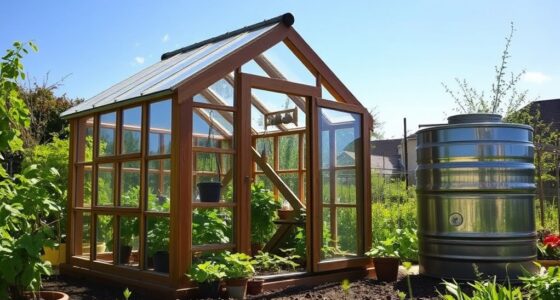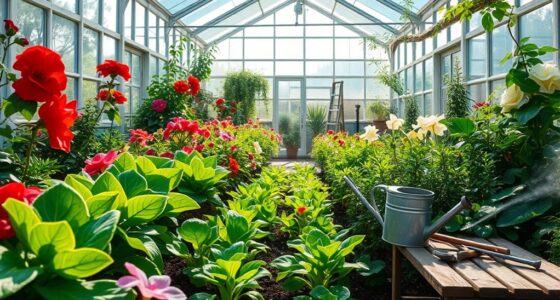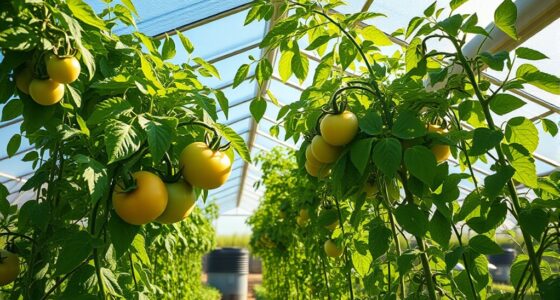To help your plants thrive, focus on blue and red LED spectrums. Blue light promotes lush foliage, strong stems, and healthy seedlings, especially during vegetative growth. Red light encourages flowering, fruiting, and overall reproductive development. Combining both spectrums offers a balanced approach that supports plants through different growth stages. For more insights on customizing LED light spectra for your plants’ success, explore further details below.
Key Takeaways
- Blue light promotes vegetative growth, encouraging lush leaves and strong stems.
- Red light stimulates flowering, fruiting, and reproductive development in plants.
- Combining red and blue spectrums supports all growth stages for healthy, vigorous plants.
- Customizing light spectrum based on plant type and growth stage maximizes growth and yield.
- Additional wavelengths like green and far-red can enhance photosynthesis and overall plant health.

Have you ever wondered how different LED lights create various effects and serve diverse purposes? When it comes to growing plants indoors, understanding the role of light color is essential. The light color emitted by LEDs influences how well your plants grow, their health, and even their flowering cycles. Different wavelengths of light can stimulate specific responses in plants, making LED spectrums a versatile choice for horticulture.
Understanding LED light colors helps optimize plant growth and flowering indoors.
For plant growth, blue and red lights are the most critical. Blue light, with its shorter wavelength, is vital during the vegetative stage. When your LED setup emits blue light, it promotes lush, healthy foliage and strong stems. If you want your plants to develop dense leaves and vigorous growth, you’ll want to ensure your lights include a good amount of blue spectrum. On the other hand, red light, with its longer wavelength, plays a significant role during flowering and fruiting stages. It encourages flowering, seed production, and fruit development, helping your plants reach their full reproductive potential.
The combination of light colors is also crucial. Many LED grow lights are designed with a mix of red and blue spectrums because these are the most effective for overall plant health. This blend supports multiple growth stages without the need for switching lights or adding other sources. When you use an LED with a balanced spectrum, you’re giving your plants the ideal conditions for steady growth from seedling to harvest. Some advanced LEDs even incorporate additional wavelengths, such as green, yellow, or far-red, to mimic natural sunlight more closely. These extra colors can enhance photosynthesis efficiency and improve overall plant vigor.
Understanding how light color impacts plant growth allows you to tailor your lighting setup to meet specific needs. If you’re growing herbs or leafy greens, emphasizing blue light will boost leaf production. For flowering plants like tomatoes or peppers, increasing red spectrum exposure can lead to more abundant blooms and fruit. Adjusting the light spectrum based on your plant’s growth stage ensures they receive the right signals to thrive.
Frequently Asked Questions
How Do LED Spectrums Affect Plant Flowering Stages?
You can influence your plants’ flowering stages by adjusting light intensity and photoperiod control. During flowering, increasing light intensity promotes healthy bud development, while a specific light schedule signals your plants to switch from growth to flowering. Using the right LED spectrum, particularly red and far-red light, enhances flowering. Properly managing these factors guarantees your plants receive ideal signals for robust flowering, leading to better yields and healthier blooms.
Can Different Plant Species Require Unique LED Light Spectrums?
You should consider that different plant species often require spectrum customization for ideal growth. Due to species adaptation, some plants thrive under specific light spectrums, while others need different wavelengths. By adjusting your LED lights to match each plant’s unique needs, you promote healthier development and better yields. Tailoring the spectrum ensures your plants receive the right light, encouraging flowering, foliage growth, or root development based on their individual requirements.
What Is the Ideal LED Spectrum for Vegetative Growth?
For ideal vegetative growth, you should focus on a blue LED spectrum, which boosts photosynthesis efficiency and encourages healthy, compact leaves. Make sure to optimize light intensity to prevent stress and promote steady growth. Combining blue light with some red can further enhance development. Adjust the spectrum based on your plants’ specific needs, ensuring they get the right balance for vigorous, healthy growth.
Do LED Spectrums Influence Plant Nutrient Uptake?
You might wonder if LED spectrums affect nutrient absorption. The answer is yes; different light wavelengths influence chlorophyll activation, which boosts photosynthesis. When chlorophyll absorbs specific colors, it enhances energy production, helping your plants take in nutrients more effectively. By providing the right spectrum, you support ideal nutrient uptake, leading to healthier growth. So, choosing the proper LED spectrum directly impacts how well your plants absorb nutrients and thrive.
How Do LED Light Spectrums Impact Plant Pest Resistance?
You might think LED spectrums only boost growth, but they also influence pest resistance. Using specific wavelengths can enhance your plant immune response, making pests less likely to attack. This acts as a natural pest deterrent strategy, reducing the need for chemicals. By selecting the right LED spectrum, you strengthen your plants’ defenses, keeping pests at bay and promoting healthier, more resilient growth.
Conclusion
So, now you know which LED spectrums boost your plants’ growth. By choosing the right colors, you’re giving your green friends the ultimate superpower to thrive and flourish. Think of it like painting a masterpiece—every hue adds a crucial touch to their health. With the right combination, you’ll turn your garden into a lush jungle, bursting with life and vitality. Your plants will thank you for revealing nature’s secret weapon—lighting that truly makes them unstoppable!










